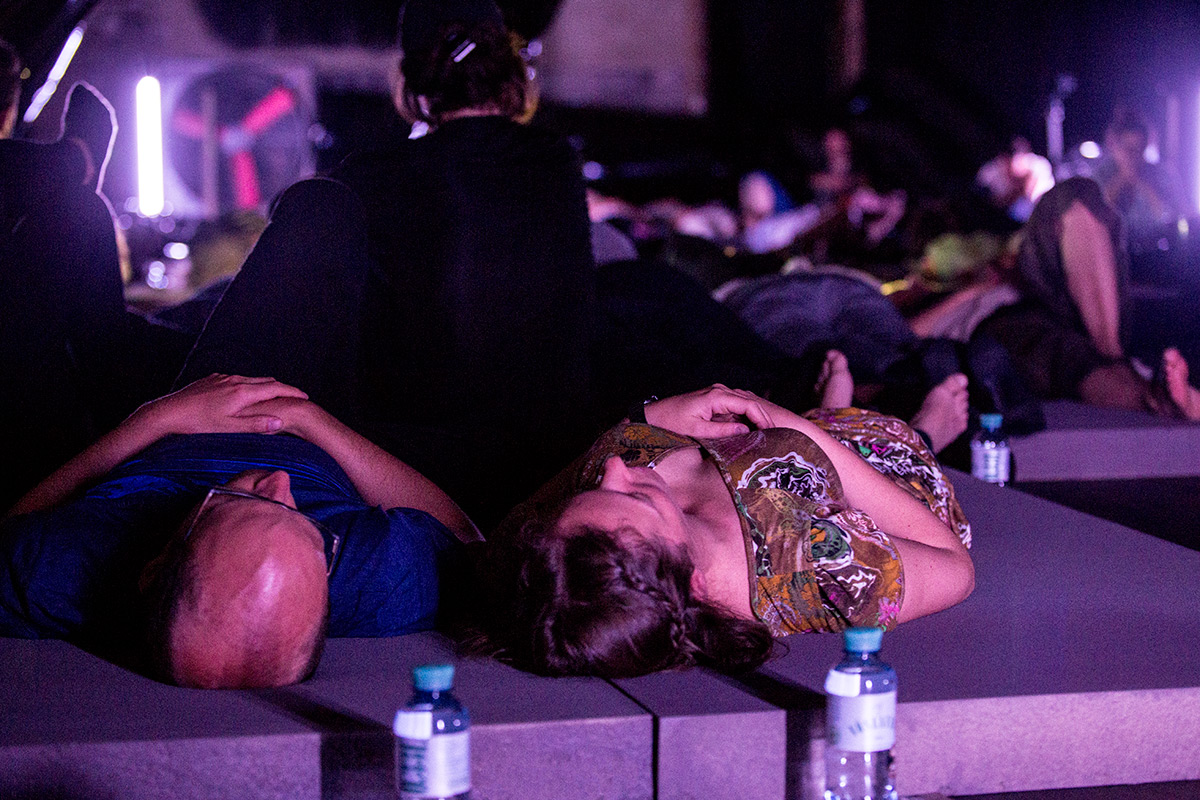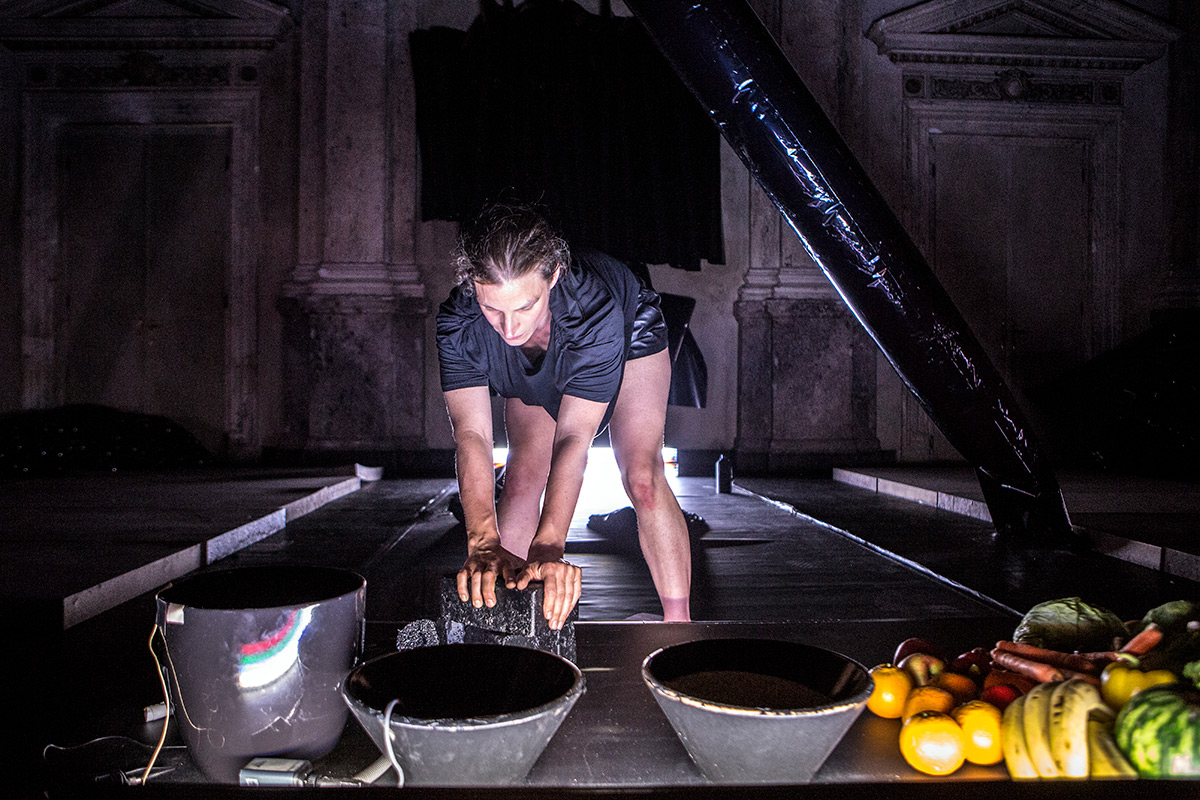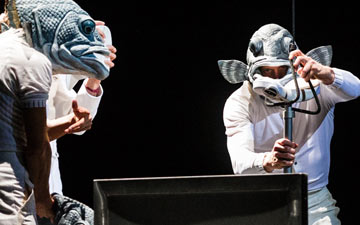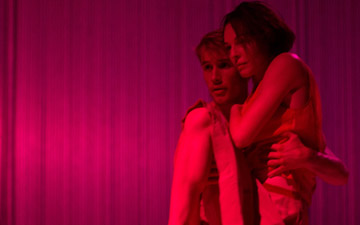
© Karolina Miernik. (Click image for larger version)
Anne Juren
Anatomie
★★✰✰✰
London, The Place
21 October 2017
Part of The Humane Body project
some Anne Juren information
www.theplace.org.uk
Imagine walking into an auditorium, (in this case The Founders’ Studio at The Place) lying down on a mat and closing your eyes for an hour. The performance begins. Anne Juren’s soothing, French-accented voice invites us to let go of our bodies and enjoy the sensation of being supported by the floor. She encourages us to follow her sensory prompts in order to experience a performance like no other. Listening only to the visual imagery that she is about to give us, I imagine that I will be taken on a delicious sensory journey and that the performance that I’ll live through will happen privately within the boundaries of my body. While I’m in a blissful meditative repose, I will be the dancer, the choreographer and spectator.
However any comparison to the relaxation section of a yoga class or preparation for somatic practice or body-mind centring workshop ends right there. Beautiful, calming imagery is not in the vocabulary of Anatomie. No, as we lie on our backs in various hypnagogic states, we are encouraged to follow imagery that is purposefully uncomfortable and at times disturbing. The territory that we find ourselves in is more Surreal than Zen, a place for dysfunctional and delirious visualisations. After an hour of lying prone, I feel that my body has been violated, cannibalised, invaded and fragmented – but very gently.

© Karolina Miernik. (Click image for larger version)
Anatomie is part of The Place’s joint project with Kaaitheater (Brussels) and Centre National de la Danse (Paris) – The Humane Body. Although the trilogy of different shows is intended to be a sensory dance adventure for all, it’s designed specifically for blind and partially sighted audiences. It’s a clever experiment.
Our first visual prompt is to imagine a tongue lying beside our bodies. This tongue, like a Salvador Dali painting escapee, proceeds to lick us in intimate and obscure places. Hypnotically it leads us to other parts of the room, over heating pipes and under furniture. Juren’s visual cues include both the fantastical and the mundane.
I fall asleep for the few minutes then awake to hear about an insect crawling over my body, and burying into various vulnerable recesses of my flesh. It too leaves and is replaced by a hand that lovingly caresses our livers, skulls, then tenderly pulls the flesh on our feet and thighs then separates muscles from bones. It could be a horror story but Juren’s voice is so reassuringly steady that I don’t feel anxious.
Finally I’m aware of a set of teeth biting into my bones and to make this image more experiential, a loud crunching sound accompanies Juren’s words. (I open my eyes briefly and see her crunching on a stick of celery).
A more pleasing metaphor is that of the little room nestled between the tibia and fibia, where a child is sleeping on a bed. Someone enters the room and looks at the child then leaves. We follow the stranger, floating out of this cosy, safe space in our joints and the performance is over.

© Karolina Miernik. (Click image for larger version)
Anatomie is not as unpleasant as it might sound. It’s highly imaginative and strangely cathartic. Like a therapy session. Theatrical devices such as sound and lighting intensify Juren’s images: sand shaken in a bowl and paper being scrunched could be the wind; slurping water sounds suggest the licking tongue and fruit splattered on the floor – the organs being manipulated by a hand. The subtle lighting changes transport you into different moods and keep you moving on this extraordinary journey. City sounds from outside the room also drift in and out of the internal performance.
Unwittingly and sometimes unwillingly I find myself excavating my body as if it were a film or a book. It’s hard work to process the often alien imagery but the mats are wonderfully comfortable and I come out feeling dazed but strangely refreshed.

















You must be logged in to post a comment.